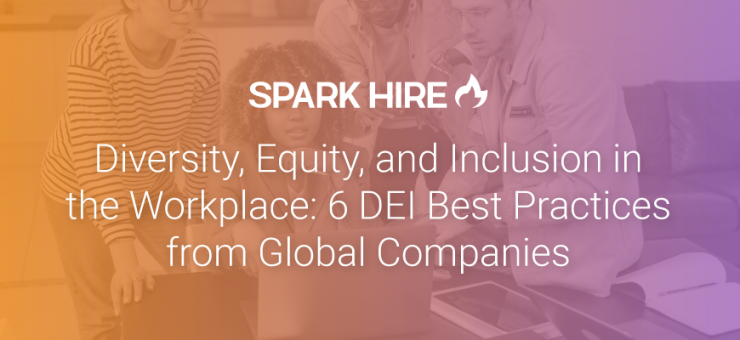A good HR manager knows what the DEI abbreviation stands for:
- Diversity − ensures that the organization involves talents and leadership of different races, ages, religions, sexual orientations, and other characteristics.
- Equity – means that an organization commits to providing the same opportunities and rights to each employee despite their position in a company, race, or anything else.
- Inclusion – guarantees that every employee is welcomed and appreciated.
A great HR manager knows how to implement DEI initiatives at their organization and keep their workplace an inclusive place for everyone. This post will review six DEI best practices. Read on!
1. Raise awareness through mentorship and educational programs
One of the most straightforward steps in implementing a sustainable DEI initiative is to raise awareness at every level of the organization.
Leverage your internal communications to speak about your commitment to creating a diverse and inclusive workplace and your further actions, like company-wide newsletters, events, social media posts, posters, etc.
You can also employ educational and mentorship programs as Starbucks does. The chain of coffee houses constantly launches educational events to raise awareness among their employees (called “partners”) and people outside the organization.
For example, Starbucks launched a mentorship program to connect Black, Indigenous, and People of Color (BIPOC) employees to top management. The goal of this program is to increase the share of BIPOC leadership through talent development and mentorship.
Also, Starbucks partnered with the National Museum of African American History and Culture to deepen the community’s knowledge and understanding of the Black American past. In terms of the initiative, Starbucks shared the museum’s content and personal stories with the community engaged volunteers in one of the largest crowdsourcing campaigns devoted to the Black American legacy.
2. Implement unbiased recruitment practices
A diverse workforce starts with your recruitment and hiring. Remember that it’s a two-way street. You need to create all conditions for unbiased recruitment internally and build an attractive, diverse-friendly company image for external candidates. Here are some proven techniques for non-biased and DEI-friendly recruitment:
- Blind hiring. With this technique, recruiters remove all candidate’s personal information like age, gender, and race to pay attention to things that matter like proven track record and job-related characteristics. Recruiters use software and browser extensions that blur images and remove the potentially biased information from candidate’s profiles and CVs. At McDonald’s, recruiters use software that blurs candidate’s photos and names to prevent bias.
- Diversity sourcing. Go outside LinkedIn and Glassdoor! For example, candidate sourcing by historically diverse college alumni, associations (like LGBTQ+), sororities, cultural interest groups, etc., increase your chances to extend the diverse talent pool.
- Internship for diverse talents. Some companies prefer to grow and develop their talent pool themselves. PwC, a consulting firm, launched a Summer Internship Program specifically for people of different racial and ethnic groups (Hispanic, Latino, Black or African American, people with disabilities, etc.) to broaden the company’s outlook and bring new ideas to the table.
- Inclusive language in job descriptions. Don’t underestimate the power of words. A study on gendered wording reveals that job descriptions with masculine-biased language push away female candidates. For instance, typical masculine-biased words include strong, lead, dominate, and competitive. They can be replaced with neutral equivalents like a proven, pioneer, inspire, and attractive instead.
3. Switch from culture fit to culture contribution
The monopoly of the “Hiring for culture fit” paradigm has been around for a while. Even though it brings benefits like improved productivity and employee engagement to organizations, it may lead to conformism and lack of inclusion in place. To combat this issue, lately, companies have been switching their mindsets from “culture fit” to “culture contribution” in their hiring processes.
The “culture contribution”, or “culture add” approach steps away from maintaining the culture and processes that have proven themselves over a particular time. Instead, the “culture add” mindset pushes organizations to hire employees of different cultural backgrounds and encourages them to express their identities. Such an approach pays off. A study by McKinsey shows that organizations that focus on bringing diverse talents to their team are 33% more profitable than their direct competitors.
4. Facilitate employee resource groups
It’s good when you have a dedicated HR function to handle the DEI processes. It’s better when you have a Chief Diversity Officer to take it to the professional level. The best option when you combine all of them and have your employees engaged too. Employee resource groups (ERGs) are one of such options.
The ERGs represent communities united by races, beliefs, nationalities, genders, etc. ERGs can be a great source of ultimate support for underrepresented communities within an organization and help you raise awareness on important issues.
For example, at Google, there are 15 employee resource groups that consist of Hispanic Googlers, African Americans, Transgender people, Greyglers (age diversity group), and more. It doesn’t mean, though, that you must invest a significant share of the HR budget on running ERGs. Since employee resource groups are organized and managed by volunteers, you can support them by sponsorship, facilities, premises for events, media partnerships, etc.
5. Reshape your internal communications
Internal communications can also contribute to your DEI success. Besides, these initiatives can be budget-friendly and require little effort.
One such option is broadening your language and content. As a rule, companies maintain their internal communications in a state language or language that prevails in the country. You can change the game rules by including bits of content in the language of underrepresented communities, as Sephora did. The company committed to adding closed captioning in their videos and increasing the Spanish language in their communications.
Think about telling the story, not just about your company, its contribution to the DEI efforts and gains. Focus on your employees instead and tell their stories. Formats like interviews, trivia, and quizzes allow you to stir interest and draw attention to your employees’ personal stories.
You can also associate stories with specific events like Wendy’s, a fast-food chain. They launched a series of interviews with the LGBTQ+ employees commemorating Pride Month and celebrating their diverse community. Another fast-food chain, White Castle, shared personal essays from their leadership devoted to their personal experience with racism. These essays helped White Castle create a sense of empathy, appreciation, and support among its employees.
6. Measure the DEI efforts
“To ensure you are moving the needle, start measuring – once you start measuring, you will know how you are moving the needle.”
Rohini Shankar, chief HR officer of CIOX Health
Like any HR function and process, DEI initiatives should be measured, tracked, and analyzed for further improvement. Typical metrics to pay your attention to include:
-
- Percentage of underrepresented groups of employees from the overall number of employees. To track this metric right, you have to define accurate criteria for diverse representatives. Some companies (like McDonald’s and Sephora) go even further. They track the percentage of diverse employees among the leadership and publish quarterly results publicly to demonstrate their commitment to creating DEI-safe workplaces.
- The number of diverse referrals. This metric is similar to a conventional “referrals” metric, focusing specifically on diverse candidates like LGBTQ+, Black, or specific age.
- The “Ranked method” metrics. It’s a qualitative metric that evaluates your DEI efforts among employees. Within this method, employees agree or disagree with the predefined statements like “My company offers enough career opportunities for LGBTQ+ employees.”
- Percentage of implemented initiatives. They represent the percentage of DEI-friendly initiatives and changes within an organization, like the percentage of Braille-friendly elevators or entrances.
About the Author
 Maryna Zavyiboroda is a Content Writer at HRForecast, a German HR tech company that develops people analytics and workforce planning SaaS solutions. Maryna considers her job the best of two worlds: the opportunity to unleash her creativity and write about meaningful topics like DEI, people development, recruitment best practices, and more.
Maryna Zavyiboroda is a Content Writer at HRForecast, a German HR tech company that develops people analytics and workforce planning SaaS solutions. Maryna considers her job the best of two worlds: the opportunity to unleash her creativity and write about meaningful topics like DEI, people development, recruitment best practices, and more.











